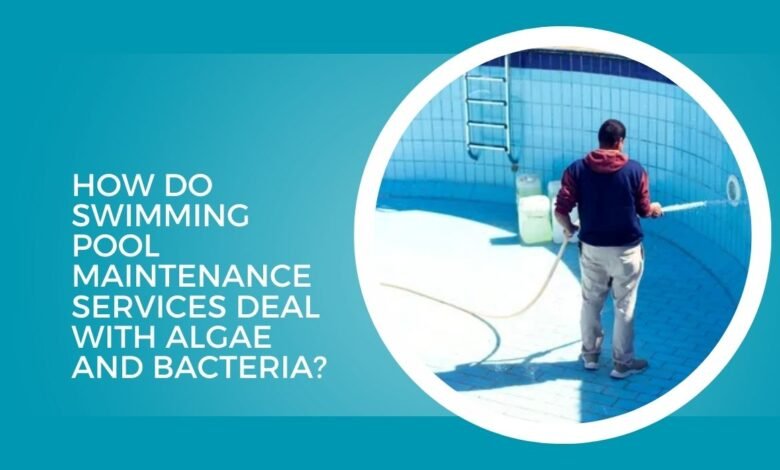
When it comes to owning a swimming pool, one of the biggest challenges is keeping the water clean, clear, and safe for swimmers. Algae and bacteria are common culprits that can quickly turn your beautiful pool into a hazardous place. These tiny organisms thrive in warm, moist environments, making your pool an ideal breeding ground if not properly maintained.
So, how do professional swimming pool maintenance services deal with these issues? What steps do they take to ensure the pool remains hygienic, clear, and safe for everyone to enjoy? In this blog post, we will dive into the process and uncover the strategies used by pool maintenance professionals to combat algae and bacteria.
Let’s get started!
The Importance of Swimming Pool Maintenance
Maintaining a swimming pool is more than just keeping it clean. Regular pool maintenance ensures that the water remains safe for swimmers, the equipment functions properly, and the overall aesthetics of the pool are maintained. The main goal of professional maintenance services is to keep your pool in excellent condition by preventing common problems, including the growth of algae and bacteria.
Note: Looking for reliable Swimming pool maintenance services UAE? Proper maintenance is essential for the longevity of your pool. Trust experienced technicians to take care of cleaning, repairs, and chemical treatments. Don’t let your pool suffer from neglect. Contact Swimming Pool Experts today for comprehensive maintenance and enjoy a hassle-free swimming experience!
What Makes Algae and Bacteria Dangerous?
Algae are tiny, plant-like organisms that thrive in warm, moist environments. They can appear in a variety of colors, such as green, yellow, black, or even red, and often float on the water’s surface or cling to pool walls. Not only do they make your pool water appear cloudy and uninviting, but algae also create slippery surfaces that pose safety risks.
Bacteria, on the other hand, are microorganisms that can cause various health issues, including skin rashes, ear infections, and even gastrointestinal problems if the water is contaminated. Bacteria can thrive in untreated or poorly maintained pool water, making it essential to address any bacterial growth promptly.
How Pool Maintenance Services Deal with Algae and Bacteria
Now that we understand the importance of maintaining a clean pool and the risks associated with algae and bacteria, let’s dive into how professional swimming pool maintenance services tackle these issues.
Regular Pool Cleaning and Skimming
One of the first steps in maintaining pool cleanliness is regular cleaning. A professional pool maintenance service typically starts by skimming the pool’s surface to remove debris, leaves, and other floating particles. While this step doesn’t directly address algae or bacteria, it’s important because debris can contribute to algae growth if left unchecked.
Skimming helps to keep the pool water clear, making it easier for pool technicians to spot early signs of algae or bacteria. Additionally, removing debris helps maintain proper water circulation and prevents organic matter from breaking down and feeding the growth of microorganisms.
Pool Brushing to Remove Algae
Brushing the walls, floor, and steps of the pool is a key step in preventing and controlling algae growth. Algae can attach itself to pool surfaces, particularly in areas that receive little water circulation, such as corners or steps. Pool professionals use special brushes to scrub these areas and loosen algae growth.
Regular brushing prevents algae from taking hold and makes it easier to remove any early growth before it spreads. By brushing the pool surfaces, maintenance experts can ensure that algae don’t have a chance to colonize and form harmful blooms.
When Does Pool Brushing Become Necessary?
If you notice any green or cloudy water, slimy surfaces, or a change in the water’s color, brushing becomes essential. Professional maintenance services often brush the pool surfaces during each service visit as part of their standard procedure to keep algae from forming.
Proper Water Circulation and Filtration
Good water circulation is crucial for keeping the pool water clean and clear. Pool filtration systems work by constantly filtering the water, removing debris, and preventing microorganisms from thriving. Professional pool maintenance services ensure that the filtration system is functioning properly by checking the filter and cleaning it when necessary.
If the filter is clogged or not working effectively, it can allow algae and bacteria to accumulate in the water. Maintaining proper circulation helps distribute chemicals like chlorine evenly, preventing the growth of algae and harmful bacteria.
How Does Water Circulation Help Control Algae?
Proper water circulation helps eliminate algae by preventing it from settling on pool surfaces. When the water is constantly moving, algae have a harder time attaching themselves and growing. Additionally, it helps to ensure that pool chemicals, such as chlorine, are properly distributed throughout the water to kill any bacteria and algae present.
Using Pool Chemicals to Kill Algae and Bacteria
The use of pool chemicals is one of the most effective methods for killing algae and bacteria. Professional pool maintenance services carefully balance the chemical levels in your pool to ensure they are optimal for maintaining water quality.
Chlorine for Algae and Bacteria Control
Chlorine is a powerful disinfectant that kills most types of bacteria and algae. It’s the most commonly used chemical in swimming pools for sanitization. Pool maintenance experts regularly check chlorine levels and adjust them to ensure the water is properly sanitized. Chlorine works by releasing chemicals that break down bacteria and algae cells, effectively neutralizing them.
Algaecides: Special Chemicals for Algae
Algaecides are specialized chemicals designed specifically to target and kill algae. When chlorine alone isn’t enough to deal with stubborn algae growth, maintenance services may apply algaecides to treat the pool. These chemicals help prevent algae from growing and eliminate existing algae blooms.
Shock Treatments
A “shock treatment” involves adding a large dose of chlorine or other sanitizing agents to the pool water to eliminate contaminants, including algae and bacteria. This method is often used after heavy pool use, poor water quality, or after algae outbreaks. Pool experts usually perform shock treatments during routine maintenance visits or if the pool water shows signs of contamination.
pH and Alkalinity Balance
Maintaining the right pH and alkalinity levels is essential for effective algae and bacteria control. If the pH level of the pool water is too high or too low, it can reduce the effectiveness of chlorine and other disinfectants. Pool maintenance professionals check the water’s pH and alkalinity levels regularly and adjust them as needed.
Why Is pH Balance Important?
The ideal pH level for swimming pools is between 7.4 and 7.6. If the pH is too low (acidic), the water can irritate your skin and eyes, and the pool equipment may corrode. If it’s too high (alkaline), chlorine becomes less effective at killing bacteria and algae. Maintaining a balanced pH ensures that your pool is both safe for swimming and capable of effectively eliminating harmful microorganisms.
Regular Monitoring and Testing
Professional pool maintenance services also conduct regular water testing to monitor the chemical levels in your pool. Testing kits are used to measure the levels of chlorine, pH, alkalinity, and other essential chemicals. By regularly testing the water, maintenance experts can detect any imbalances early on and make adjustments before algae and bacteria have a chance to proliferate.
What Does a Regular Pool Test Include?
A typical pool water test checks the following levels:
- Chlorine: To ensure the water is adequately sanitized.
- pH: To keep the water balanced for swimmer comfort and effective chlorine use.
- Alkalinity: To help stabilize pH levels.
- Calcium Hardness: To prevent scaling and corrosion.
- Cyanuric Acid: To help stabilize chlorine in outdoor pools.
Addressing Heavy Algae Blooms
Sometimes, algae growth can get out of control, forming large blooms that turn your pool water green, brown, or cloudy. In such cases, professional pool services may need to take additional measures. These may include:
- Algae Scrubbing: When algae blooms are extensive, maintenance experts may need to scrub pool surfaces multiple times to fully remove algae.
- Additional Chemical Treatments: A combination of algaecides, chlorine, and shock treatments may be necessary to eliminate stubborn algae.
- Vacuuming: After algae are broken down, vacuuming the pool helps remove the algae particles from the water.
Closing Thoughts: Keeping Your Pool Safe from Algae and Bacteria
Maintaining a swimming pool requires regular care and attention to ensure it stays free of harmful algae and bacteria. Pool maintenance professionals use a variety of techniques, from chemical treatments to regular cleaning and proper filtration, to keep your pool safe, clean, and enjoyable year-round. By staying on top of routine maintenance and addressing any signs of algae or bacteria growth promptly, you can enjoy a healthy and inviting pool for years to come.
For More Insightful Articles Related To This Topic, Feel Free To Visit: toastul.

